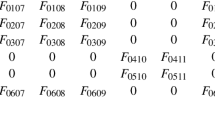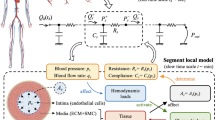Abstract
Platelet activation is a precursor for blood clotting, which plays leading roles in many vascular complications and causes of death. Platelets can be activated by chemical or mechanical stimuli. Mechanically, platelet activation has been shown to be a function of elevated shear stress and exposure time. These contributions can be combined by considering the cumulative stress or strain on a platelet as it is transported. Here, we develop a framework for computing a hemodynamic-based activation potential that is derived from a Lagrangian integral of strain rate magnitude. We demonstrate that such a measure is generally maximized along, and near to, distinguished material surfaces in the flow. The connections between activation potential and these structures are illustrated through stenotic flow computations. We uncover two distinct structures that may explain observed thrombus formation at the apex and downstream of stenoses. More broadly, these findings suggest fundamental relationships may exist between potential fluid mechanic pathways for mechanical platelet activation and the mechanisms governing their transport.
Similar content being viewed by others
References
Alemu Y, Bluestein D (2007) Flow-induced platelet activation and damage accumulation in a mechanical heart valve: numerical studies. Artif Organs 31(9): 677–688
Aurell E, Boffetta G, Crisanti A, Paladin G, Vulpiani A (1997) Predictability in the large: an extension of the concept of Lyapunov exponent. J Phys A 30(1): 1–26
Barstad RM, Roald HE, Cui Y, Turitto VT, Sakariassen KS (1994) A perfusion chamber developed to investigate thrombus formation and shear profiles in flowing native human blood at the apex of well-defined stenoses. Arterioscler Thromb Vasc Biol 14(12): 1984–1991
Bluestein D, Niu L, Schoephoerster R, Dewanjee M (1997) Fluid mechanics of arterial stenosis: relationship to the development of mural thrombus. Ann Biomed Eng 25(2): 344–356
Boreda R, Fatemi RS, Rittgers SE (1995) Potential for platelet stimulation in critically stenosed carotid and coronary arteries. J Vasc Invest 1(1): 26–37
Cho YI, Kensey R (1991) Effects of the non-Newtonian viscosity of blood flows in a diseased arterial vessel part 1: steady flows. Biorheology 28: 241–262
Cokelet GR (1972) The rheology of human blood. In: Fung YC, Perrone N, Anliker M (eds) Biomechanics: its foundations and objectives. Prentice-Hall, Englewood Cliffs, pp 63–103
Colantuoni G, Hellums JD, Moake JL, Alfrey CP (1977) The response of human platelets to shear stress at short exposure times. Trans Am Soc Artif Int Organs 23: 626–631
Haller G, Yuan G (2000) Lagrangian coherent structures and mixing in two-dimensional turbulence. Phys D Nonlinear Phenom 147(3–4): 352–370
Hellums JD (1994) 1993 Whitaker lecture—biorheology in thrombosis research. Ann Biomed Eng 22(5): 445–455
Jansen KE, Whiting CH, Hulbert GM (2000) A generalized-α method for integrating the filtered Navier–Stokes equations with a stabilized finite element method. Comput Method Appl Mech Eng 190(3–4): 305–319
LaDisa JF, Hettrick DA, Olson LE, Guler I, Gross ER, Kress TT, Kersten JR, Warltier DC, Pagel PS (2002) Stent implantation alters coronary artery hemodynamics and wall shear stress during maximal vasodilation. J Appl Phys 93(6): 1939–1946
Lapeyre G, Hua BL, Legras B (2001) Comment on “Finding finite-time invariant manifolds in two-dimensional velocity fields” [Chaos 10, 99, (2000)]. CHAOS 11(2): 427–430
Lekien F, Shadden SC, Marsden JE (2007) Lagrangian coherent structures in n-dimensional systems. J Math Phys 48(6): 065404-1–065404-19
Maxey MR, Riley JJ (1983) Equation of motion for a small rigid sphere in a nonuniform flow. Phys Fluids 26: 883–889
Nesbitt WS, Westin E, Tovar-Lopez FJ, Tolouei E, Mitchell A, Fu J, Carberry J, Fouras A, Jackson SP (2009) A shear gradient-dependent platelet aggregation mechanism drives thrombus formation. Nat Med 15(6): 665–673
Nobili M, Sheriff J, Morbiducci U, Redaelli A, Bluestein D (2008) Platelet activation due to hemodynamic shear stresses: damage accumulation model and comparison to in vitro measurements. Am Soc Artif Int Organs J 54(1): 64–72
Pedley TJ (1980) The fluid mechanics of large blood vessels. Cambridge University Press, Cambridge
Purvis NB, Giorgio TD (1991) The effect of elongational stress exposure on the activation and aggregation of blood-platelets. Biorheology 28(5): 355–367
Ramstack JM, Zuckerman L, Mockros LF (1979) Shear-induced activation of platelets. J Biomech 12(2): 113–125
Rubenstein D, Yin W (2010) Quantifying the effects of shear stress and shear exposure duration regulation on flow induced platelet activation and aggregation. J Thromb Thrombolys 30(1): 36–45
Schmidt JP, Delp SL, Sherman MA, Taylor CA, Pande VS, Altman RB (2008) The simbios national center: systems biology in motion. Proc IEEE 96(8): 1266–1280
Shadden S, Katija K, Rosenfeld M, Marsden J, Dabiri J (2007) Transport and stirring induced by vortex formation. J Fluid Mech 593: 315–332
Shadden SC (2011) Lagrangian coherent structures. In: Grigoriev R (ed) Transport and Mixing in Laminar Flows: From Microfluidics to Oceanic Currents. Wiley-VCH Verlag GmbH & Co. KGaA, New York, pp 59–89
Shadden SC, Taylor CA (2008) Characterization of coherent structures in the cardiovascular system. Ann Biomed Eng 36(7): 1152–1162
Shadden SC, Lekien F, Marsden JE (2005) Definition and properties of Lagrangian coherent structures from finite-time Lyapunov exponents in two-dimensional aperiodic flows. Phys D 212(3–4): 271–304
Shadden SC, Dabiri JO, Marsden JE (2006) Lagrangian analysis of fluid transport in empirical vortex ring flows. Phys Fluids 18(4): 047105-1–047105-11
Shakib F, Hughes TJR, Johan Z (1989) A multi-element group preconditioned GMRES algorithm for nonsymmetric systems arising in finite-element analysis. Comput Method Appl Mech Eng 75 (1–3): 415–456
Sheriff J, Bluestein D, Girdhar G, Jesty J (2010) High-shear stress sensitizes platelets to subsequent low-shear conditions. Ann Biomed Eng 38(4): 1442–1450
Tambasco M, Steinman DA (2003) Path-dependent hemodynamics of the stenosed carotid bifurcation. Ann Biomed Eng 31(9): 1054–1065
Taylor CA, Hughes TJR, Zarins CK (1998) Finite element modeling of blood flow in arteries. Comput Method Appl Mech Eng 158 (1–2): 155–196
Wang N, Butler JP, Ingber DE (1993) Mechanotransduction across the cell surface and through the cytoskeleton. Science 260: 1124–1127
Young D, Tsai F (1973) Flow characteristics in models of arterial stenosis—I steady flow. J Biomech 6(4): 395–402
Author information
Authors and Affiliations
Corresponding author
Rights and permissions
About this article
Cite this article
Shadden, S.C., Hendabadi, S. Potential fluid mechanic pathways of platelet activation. Biomech Model Mechanobiol 12, 467–474 (2013). https://doi.org/10.1007/s10237-012-0417-4
Received:
Accepted:
Published:
Issue Date:
DOI: https://doi.org/10.1007/s10237-012-0417-4




